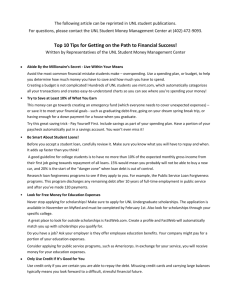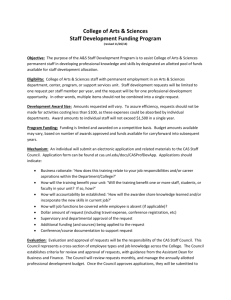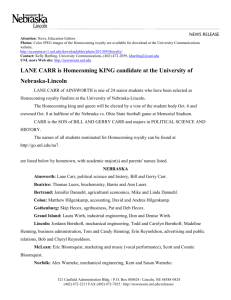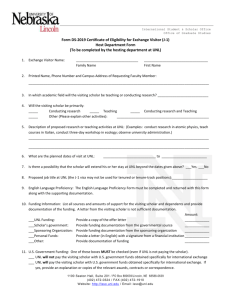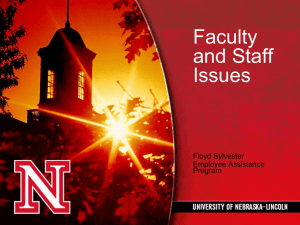introduction
advertisement
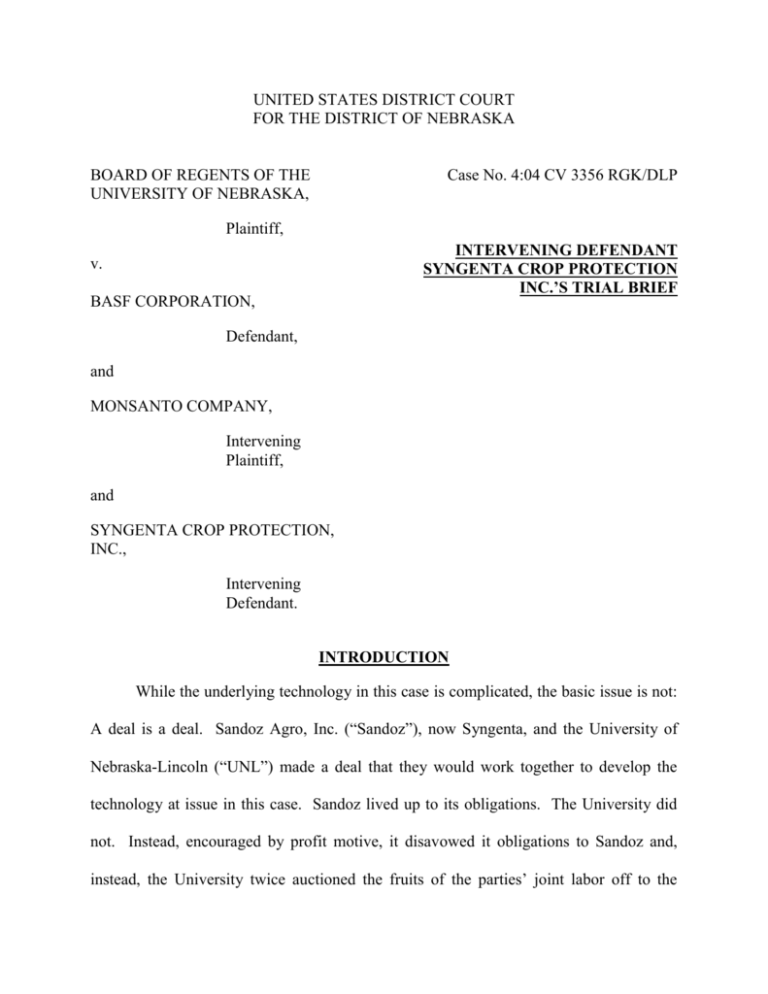
UNITED STATES DISTRICT COURT FOR THE DISTRICT OF NEBRASKA BOARD OF REGENTS OF THE UNIVERSITY OF NEBRASKA, Case No. 4:04 CV 3356 RGK/DLP Plaintiff, INTERVENING DEFENDANT SYNGENTA CROP PROTECTION INC.’S TRIAL BRIEF v. BASF CORPORATION, Defendant, and MONSANTO COMPANY, Intervening Plaintiff, and SYNGENTA CROP PROTECTION, INC., Intervening Defendant. INTRODUCTION While the underlying technology in this case is complicated, the basic issue is not: A deal is a deal. Sandoz Agro, Inc. (“Sandoz”), now Syngenta, and the University of Nebraska-Lincoln (“UNL”) made a deal that they would work together to develop the technology at issue in this case. Sandoz lived up to its obligations. The University did not. Instead, encouraged by profit motive, it disavowed it obligations to Sandoz and, instead, the University twice auctioned the fruits of the parties’ joint labor off to the highest bidder—first UAP and then later Monsanto. As a result, the University has enjoyed a windfall while Sandoz was denied the benefits of its bargain. Syngenta intervened in this action to protect its non-exclusive license rights under the contract between Sandoz and UNL (the “Contract”), and its ownership rights to the dicamba-resistance technology under the Contract and under the patent laws. Under the patent law, Syngenta is entitled to joint ownership of the patents at issue if its employees substantially contributed to the development of those patents. These rights are independent of any contractual obligation, but as a joint inventor, Syngenta is entitled to sole ownership of those patents under the terms of the Contract. By contrast, the Contract provides broader ownership rights for inventions jointly made by Sandoz and UNL, even if they do not rise to the level of “joint inventorship” under the patent law. Under either theory or both theories, Syngenta is the owner. Syngenta requests that the Court require UNL to abide by the terms of the Contract and the patent laws, and provide Syngenta with the fruits of the Contract. ARGUMENT I. UNDER THE UNDISPUTED TERMS OF THE SANDOZ/UNL CONTRACT, SANDOZ IS THE OWNER OF THE TECHNOLOGY DEVELOPED UNDER THE CONTRACT That UNL made a deal with Sandoz is uncontroverted. Nor is there a dispute as to the basic terms of that deal. UNL entered into a contract under which Sandoz funded Dr. Weeks’ lab in exchange for a non-exclusive license to the technology as well as ownership of that technology under two scenarios: (1) If Sandoz and UNL were joint inventors on any patents arising out of their work, then Sandoz would own those patents; 2 and (2) if Sandoz and UNL scientists jointly made inventions (not limited to patents) through their collaboration then Sandoz would own those inventions. The evidence will show that by the time the Contract expired in March 1997, UNL and Sandoz had made significant progress toward the goal of producing dicambaresistant plants. In fact, some of Sandoz’s progress and contributions to this goal, as discussed in greater detail below, are reflected in what became the claims in the Weeks patents held by UNL. By late 1996, Sandoz divested its U.S. and Canadian dicamba business by selling specified assets to BASF under an Asset Purchase Agreement. 1 At the same time, however, Sandoz retained robust post-expiration rights under the Contract, including the ownership rights it acquired as a joint inventor, as a joint developer, and as a non-exclusive licensee to the technology. When UNL learned that Sandoz did not intend to renew its funding, it began to shop around its technology. In 1997, it opened the bidding to UAP and BASF, taking the highest bid from UAP.2 At approximately the same time, UNL began to seek patent protection for the technology it had developed with Sandoz. Weeks immediately recognized that, under the terms of the Contract, UNL had a duty to provide Sandoz with copies of the materials relevant to its patent applications. The undisputed evidence will show that Dr. Weeks acknowledged, in an internal memorandum sent to Vice Chancellor 1 2 Because BASF’s crossclaims against Syngenta relating to rights under the Asset Purchase Agreement have now been dismissed with prejudice, BASF has waived any claims that were or could have been encompassed within its crossclaims, including any claims as to ownership or license rights of dicamba resistance technology under the Asset Purchase Agreement. UNL repeated this process again in 2004, this time the bidders were BASF and Monsanto. Monsanto’s bid substantially exceeded BASF’s and UNL selected it. 3 Don Hellmuth, that the University was obligated to provide Sandoz a complete written disclosure of its invention. Yet, no disclosure was ever made to Sandoz or BASF. UNL, apparently seduced by the prospect of huge profits flowing to the University, decided to say nothing. The evidence will show that neither before nor after the divestitutre did Sandoz know that UNL was applying for patents on work that had been performed by Sandoz and only Sandoz. Had Sandoz known what was in these applications, it could have addressed that issue at the time in front of the Patent Office under a preponderance of the evidence standard, rather than before the Court under a clear and convincing standard. Aware of that fact, the clear conclusion is that UNL remained silent because it did not want to risk losing its unjustified windfall. Yet, at the same time UNL seeks to avoid its contractual obligations, it contends that it is entitled to continue making use of DI-6 bacterium, which Sandoz had permitted UNL to use during the term of the Contract. The use of DI-6 is covered by a Sandoz patent. UNL and Monsanto cannot have it both ways. They cannot disavow the Contract while simultaneously seeking shelter in its provisions. II. SANDOZ AND DR. WEEKS/UNL COLLABORATED EXTENSIVELY OVER THE YEARS TO JOINTLY DEVELOP AND INVENT THE SUBJECT MATTER OF THE CLAIMS OF THE ‘896 PATENT But that is precisely what Plaintiffs Monsanto and UNL are attempting to do in this case. Plaintiffs want to renege on the deal by taking the litigation-induced position that all of Sandoz’s contributions to the development of the dicamba-resistance technology should be ignored either because: (1) they predate the Contract between the 4 parties and were not, therefore, made pursuant to the Contract; (2) they came after conception of the claimed inventions; (3) to the extent they came before conception, because they were “routine” or publicly known; or (4) that Sandoz scientists are not joint inventors because they did not complete conception. These post hoc rationalizations focus on hypertechnical—and incorrect—legal assertions to justify UNL’s behavior, but the real proof comes from what Dr. Weeks, UNL, Sandoz and the Patent Office did and said long before this lawsuit came to fruition. The evidence will show: that Dr. Weeks and UNL relied heavily on Sandoz’s prior work with DI-6; that there was extensive collaboration and communication between UNL and Sandoz during the term of the Contract and its extensions; and that Sandoz was the first to achieve the results required by many of the claims of the ‘896 Patent. A. Sandoz Conducted the Foundational Work on Dicamba Resistance During the 1980s While Dr. Weeks Was at Sandoz A party may rebut the presumption that the named inventors are the true and only inventors by providing clear and convincing evidence that it should be a named inventor. Checkpoint Systems, Inc. v. All-Tag Sec. S.A., 412 F.3d 1331, 1338 (Fed. Cir. 2005). “Conception is the touchstone for determining inventorship,” Fina Oil, 123 F.3d at 1473, which requires a definite and permanent idea of how to solve a particular problem. Burroughs Wellcome, 40 F.3d at 1228. A joint invention is “simply the product of a collaboration between two or more persons working together to solve the problem addressed.” Fina Oil, 123 F.3d at 1473. The contribution to that collaboration can be experimental, Id., and can be to as little as a single limitation of a single claim. Eli Lilly 5 and Co. v. Aradigm Corp., 376 F.3d 1352, 1361-62 (Fed. Cir. 2004); Stern v. Trustee of Columbia University, 434 F.3d 1375, 1378 (Fed. Cir. 2006). Collaboration need not be extensive but requires a minimal quantum of awareness of each other’s work. KimberlyClark Corp. v. Proctor & Gamble Distrib., 973 F.2d 911, 917 (Fed. Cir. 1992). In the mid-1980s, Sandoz scientists Krueger, Butz and Atallah discovered and characterized a strain of bacteria known as DI-6, which has the ability to metabolize the broad-leaf herbicide dicamba. Dr. Weeks, the lead named inventor of the ‘896 Patent, became involved in the DI-6 project at Sandoz. Sandoz’s initial work on DI-6, including work by Dr. Weeks as an employee of Sandoz, continued for several years. During this time, the Sandoz team made the critical breakthroughs suggesting the feasibility that the DI-6 bacteria could be used to transform higher plants to impart dicamba resistance. The Sandoz team proceeded to map out a strategy for how it would isolate the genes responsible for degrading dicamba and transform plants to make them resistant to the herbicide. Funding for the dicamba project at Sandoz dried up in the late eighties, and Dr. Weeks left Sandoz to join the faculty at UNL in late 1989. The evidence will show that when he left, Dr. Weeks took many of the confidential, internal research reports related to Sandoz’s work on dicamba-resistance, including the documents outlining the strategy for imparting dicamba-resistance in plants. The evidence will show that Dr. Weeks used those materials to continue work on the dicamba project at UNL. The work of Sandoz during the 1980s significantly contributed to the subject matter of the claims that later issued in the ‘896 Patent. Plaintiffs argue that Sandoz’s 6 contributions during the 1980s should not count for purposes of determining whether Sandoz is a joint inventor or developer of the ‘896 Patent3 because those contributions pre-date the Sandoz-UNL Contract. This argument is flawed for at least two reasons. First, statutory joint inventorship rights exist independent of any contractual rights. 35 U.S.C. § 116. Nothing in the statute requires that two or more persons are joint inventors only if their inventive contributions were made pursuant to a contract. Indeed, contributions that differ in kind, scope or time can all be sufficient to qualify as contributions to joint inventorship. Monsanto Co. v. Kamp, 269 F.Supp. 818, 824 (D. D.C. 1967). Second, nothing in the contract limits the possibility that each of the parties would bring pre-existing information that would facilitate further inventions made during the term of the agreement. Indeed, it was Sandoz’s pre-existing knowledge relating to dicamba that Dr. Weeks sought when he asked to partner with them. Plaintiffs further argue that Sandoz’s work in the 1980s should not count because it later became public. This is both factually and legally incorrect. Sandoz’s contributions were not limited to the information that was publicly disclosed, but included the knowledge and experience necessary to achieve the objective of developing dicamba-resistant plants. If all of Sandoz’s knowledge had been in the public domain, UNL would not have needed the substantial technical assistance that Sandoz provided. Furthermore, it is legally wrong. A co-inventor’s contribution is not negated by 3 For purposes of this brief, Syngenta solely refers to the ‘896 Patent. The same arguments apply equally, however, to the ‘724 Patent and the PCT applications flowing from the same disclosure in that those documents explicitly call out constructs for the expression of oxygenase in host cells and plants—constructs that Sandoz designed and prepared. 7 public disclosure of that information. Pannu v. Iolab Corp., 155 F.3d 1344, 1351 (Fed. Cir. 1998). B. Dr. Weeks Sought and Obtained Funding and Research Assistance from Sandoz 1. Sandoz Substantially Contributed to the Conception of the DI-6 Oxygenase DNA Sequence In addition to the monetary support, Sandoz provided specific, technical contributions to the conception of claims 1, 2 and 5 of the ‘896 Patent both during the 1980s (as described above) and also under the Contract. For instance, the evidence will show that prior to conception, Sandoz contributed to the isolation and sequencing of the oxygenase gene by advising UNL on protein purification. In addition, Patricia Herman, who was the individual in Dr. Weeks’ lab responsible for identifying the oxygenase sequence, did not have a definite and permanent idea—that is, conception—of the final gene sequence until April 30, 1996. Prior to that time, Sandoz provided assistance to Dr. Herman by identifying errors in the nucleotide sequence for the oxygenase gene. In particular, Sandoz performed restriction digests in preparation for building expression constructs for the oxygenase gene. It then performed in vitro experiments to establish that the cloned gene fragment not only produced a protein, but a protein of the anticipated length. This work encouraged UNL to continue further sequencing the gene fragment and to ultimately obtain the full sequence. Plaintiffs argue that Sandoz is not a joint inventor of the ‘896 Patent because no one from Sandoz was present when the final, complete gene sequence was isolated. Plaintiffs’ argument is legally flawed. Plaintiffs mistakenly read the law which states that 8 conception of a DNA sequence is not complete until it has been fully isolated and identified with the notion that the only contribution of import is the moment that the final sequence is isolated. This is wrong. Just because a contribution occurs prior to the moment of conception does not mean that an inventor loses his status as a joint inventor. Rhone-Poulenc Agro v. Monsanto Co., 445 F. Supp.2d 531, 547 (M.D.N.C. 2006); Fina Oil & Chem. v. Ewen, 123 F.3d 1466, 1474 (Fed. Cir. 1997). Sandoz’s work in providing a road map of how to isolate the gene sequence through protein purification and in assisting with the identification of the DI-6 oxygenase gene sequence were substantial contributions that should not be negated merely because Sandoz inventors were not present when Dr. Herman obtained the final oxygenase sequence. 2. Sandoz Substantially Contributed to the Conception of the Claims Pertaining to the Expression of Oxygenase in Transgenic Host Cells and Plants Sandoz also made significant contributions to the remaining claims of the ‘896 Patent. Claims 3, 4, 6 and 7 of the ‘896 Patent claim priority to the provisional application filed by UNL. They are directed to the detection of oxygenase expression in host cells. Prior to the filing of the provisional application of the ‘896 Patent, on April 4, 1997, UNL had not detected expression of the oxygenase gene in host cells. The evidence will show that after it filed the ‘896 Patent application, UNL was unable to detect the expression of oxygenase in host cells even though Sandoz had succeeded in achieving the results required by claims 3, 4, 6 and 7 and communicated the results of its work to UNL a year before UNL filed its patent applications. 9 Without any acknowledgement of Sandoz’s contribution, UNL claimed credit for this work in the Patent Office. The same is true of the claims directed to plants. As of the filing of the provisional application, UNL had not: (1) transformed a single plant with the oxygenase gene as required by claims 9 and 10; (2) prepared constructs to express the oxygenase gene in plants as required by claims 8, 11 and 12; or (3) selected for plant cells by either using a medium containing dicamba as required in claim 13. The evidence will show that Sandoz had either accomplished or removed major obstacles to accomplishment of these milestones prior to the time UNL filed its patent applications in April 1997. Plaintiffs do not dispute that Sandoz achieved these milestones prior to the time that it filed the ‘896 provisional application. Rather, Plaintiffs contend that Sandoz’s myriad contributions, which were explicitly claimed as inventions by UNL in the ‘896 Patent, should not count because the only real “inventive” activity was obtaining the sequence for the oxygenase gene. To wit, Plaintiffs contend that conception was complete once UNL had the DNA sequence and that all of the contributions made by Sandoz after the sequence was identified were “routine” and therefore not worthy of joint inventorship. The evidence will also show that the patent examiner who was involved in the prosecution of the ‘896 Patent was reluctant to allow the claims of the patent because the field of genetic engineering is unpredictable and, therefore, conception requires the results required by the claims. Amgen, Inc. v. Chugai Pharmaceutical Co., Ltd., 927 F.2d 1200, 1206 (Fed. Cir. 1991). Indeed, Dr. Herman admitted that, short of actually 10 inserting a bacterial gene into a plant, there can be no definite and firm idea of how to achieve the results required by the claims. In order to overcome the patent examiner’s concerns, the evidence will show that UNL was required to provide proof of the same kind of work that Sandoz had completed—but had not been disclosed to the Patent Office—prior to filing. UNL knew that the claimed results could be achieved precisely because Sandoz had already demonstrated such success. Although Plaintiffs now claim that the DNA sequence—by itself—was sufficient to enable a person of ordinary skill in the art to reduce to practice the remaining claimed inventions, and hence evidence conception, the contemporaneous facts belie that assertion. Proof of conception requires “a definite and permanent reflection of the complete idea as it will be used in practice.” Burroughs Wellcome Co. v. Bar Labs., Inc., 40 F.3d 1223, 1228 (Fed. Cir. 1994); Invitrogen v. Clontech Labs., Inc., 429 F.3d 1052, 1064 n.8 (Fed. Cir. 2005). The facts will show that even after Sandoz had achieved success in obtaining expression of oxygenase in transgenic host cells before UNL filed, UNL was unable to obtain expression of the oxygenase gene when they prepared their own expression construct after the filing of the ‘896 Patent application. It is disingenuous for Plaintiffs to now argue that the contributions provided by Sandoz were “routine” when Dr. Weeks and UNL could not reduce those claims to practice without significant experimentation. (“A conception is not complete if the subsequent course of experimentation, especially experimental failures, reveals uncertainty that so undermines the specificity of the 11 inventor’s idea that it is not yet a definite and permanent reflection of the complete idea as it will be used in practice.” Invitrogen Corp. v. Clontech Labs., Inc., 429 F.3d 1052, 1064 (Fed. Cir. 2005) (quoting Burroughs Wellcome Co. v. Barr Labs., Inc., 40 F.3d 1223, 1229 (Fed. Cir. 1994). Plaintiffs now contend that Sandoz’s contributions were “routine,” but have not provided a shred of evidence to corroborate a date of conception by UNL that pre-dates the contributions by Sandoz scientists. Lacking any evidence to corroborate that conception was complete prior to the time it filed its patent applications, UNL’s claim that it is the true and sole inventor of the ‘896 Patent fails. Price v. Symsek, 988 F.2d 1187, 1194-95 (Fed. Cir. 1993); Medichem, S.A. v. Rolabo, S.L., 437 F.3d 1157, 1171 (Fed. Cir. 2006). It is only now, in litigation, that Plaintiffs contend that Sandoz’s contributions were “routine.” C. Sandoz Jointly Made the Inventions Disclosed in the ‘896 Patent Under the Terms of the Sandoz Agro-UNL Contract Regardless of Whether it is a Joint Inventor under Patent law The operative language of the Sandoz-Agro-UNL Contract provides that, “Title to inventions including know-how or resulting patents made jointly by UNIVERSITY and SPONSOR personnel shall be assigned to SPONSOR . . .” Contract § 10. State law governs the interpretation of contracts relating to the ownership of patent rights. Jim Arnold Corp. v. Hydrotech Sys., Inc., 109 F.3d 1567, 1572 (Fed. Cir. 1997); Consolidated World Housewares, Inc. v. Finkle, 831 F.2d 261, 265 (Fed. Cir. 1987).. Nebraska law requires that a court first determine whether a contract is ambiguous. Eagle Run Square II, L.L.C. v. Lamar’s Donuts Intern., Inc., 740 N.W.2d 43, 48-49 (Neb. Ct. App. 2007). 12 If the contract is clear on its face, “then the intentions of the parties must be determined from the contract itself.” Id. Regardless of whether Sandoz is a joint inventor for purposes of patent law, Sandoz and UNL entered into a contract that provides that all inventions made jointly, including but not limited to patents, were to be disclosed and assigned to Sandoz. The contract in this case is clear that the scope of assignment under the contract is broader than the language of the patent statute. That is, because the inventions set forth in the contract are broader than just patented inventions, there is no reason to assume that the parties meant to be limited to the definition of joint inventorship under the Patent Act. Indeed, the courts have repeatedly affirmed that parties may contract to a lower standard for assignment of inventions beneath what is required for the Patent Office to identify a party as a joint inventor. See, e.g., Sunbeam Products, Inc. v. Wing Shing Products (BVI) Lts, 311 B.R. 378, 392-93 (S.D.N.Y. 2004); American Tel. and Tel. Co. v. Integrated Network Corp., 972 F.3d 1321, 1324 (Fed. Cir. 1992). The evidence will show that, at a minimum, Sandoz jointly made the inventions that were patented in the ‘896 Patent. Plaintiffs’ attempts to suggest that Sandoz was not at least a co-developer of the patented inventions are merely post-hoc rationalizations to justify its own failure to notify Sandoz of its decision to exclude Sandoz personnel as inventors in filing the patent. The Court should reject Plaintiffs arguments for what they are—litigation-induced necessities. A deal is a deal. Sandoz substantially contributed to the invention of the ‘896 Patent. As such, it is entitled to the statutory and contractual benefits of its labor. 13 III. SYNGENTA HAS NON-EXCLUSIVE LICENSE RIGHTS UNDER THE CONTRACT In addition to the ownership interests discussed above, Syngenta is entitled to a declaration that it has an irrevocable, world-wide, fully paid up, unrestricted, nonexclusive license, with the full right to sublicense, the dicamba-resistance technology. A. The Contract Grants Non-Exclusive License Rights Section 10 of the Contract provides: In return for the significant funding provided, UNIVERSITY hereby grants to SPONSOR an irrevocable, world-wide, fully paid up, unrestricted, nonexclusive license with the full right to sublicense to make, have made, use or sell any invention including know-how and resulting patents in the field of crops resistant to dicamba and all genetic material related to deriving dicamba resistance to which UNIVERSITY has any right, title and/or interest in accordance with this CONTRACT. (hereinafter, the “Sandoz Agro/UNL License”). SPONSOR was defined in the Contract as Sandoz Agro, Inc., and its “Affiliated companies.” Thus, pursuant to the Contract, Sandoz Agro and its Affiliated companies are entitled to a world-wide, non-exclusive license to the dicamba-resistance technology. B. Syngenta is an “Affiliated company” of Sandoz Agro Syngenta is entitled to the same world-wide, non-exclusive license to the dicambaresistance technology because Syngenta is an affiliate of Sandoz Agro. The evidence will show that Syngenta became an affiliate of Sandoz Agro in December 1996, when they both became wholly owned by the same parent. Sandoz Agro had funded the Contract through March 1, 1997. Accordingly, Syngenta became an affiliate of Sandoz Agro while the Contract was still being funded by Sandoz Agro. 14 C. The Contract Applies to After-Created Affiliates The Court has held that the term “Affiliated companies” is ambiguous as to whether the Contract was intended to apply to Sandoz Agro affiliates that did not exist on the date the Contract was executed. (November 6, 2007, Order, Doc. #343). UNL would have the Court revise the Contract to add the words “in existence at the time of the execution of this Contract” after the words “Affiliated companies.” The Court may not rewrite the Contract, of course, and there is nothing on the face of the Contract -- which was apparently drafted by UNL—that would suggest that the parties intended, but forgot, to include the limiting language UNL now seeks to impose. Other courts, faced with the same issue, look to the terms of the contract and determine whether or not the contract was an ongoing contract that would have future benefits to the parties and thus should apply to future affiliated companies. See Insurance Company of North America v. Raymond E. Kelley, Inc., No. 6878/91, slip op. (Sup. Ct. N.Y. County Nov. 12, 1991) (Attached as Exhibit A); Seaboard Surety Company v. Crane and Company, Inc., 1999 WL 58675 (S.D.N.Y. Feb. 5, 1999) (Attached as Exhibit B); and GTE Wireless, Inc. v. Cellexis International, Inc., 341 F.3d 1 (1st Cir. 2003). In this case, as in Raymond E. Kelley and Seaboard, the Contract is an ongoing contract that would have future benefits to the parties, and the Contract specifically contemplated future actions from both parties. UNL and Sandoz Agro agreed to perform research into dicamba resistant crop plants in the future and Sandoz Agro was going to pay specified sums to UNL through March 1, 1997, and an additional $100,000 upon first 15 market introduction of a dicamba resistant crop seed. Thus, it is appropriate to read the Contract as contemplating and encompassing future “Affiliated companies” of Sandoz Agro since Sandoz Agro was going to perform research in the future and was required to make payments in the future. Further, at the time the Contract was entered into, there were no immediate benefits for Sandoz Agro. The dicamba-resistance technology was still being developed. All of the fruits of the Contract for Sandoz Agro and its “Affiliated companies” would ripen in the future, upon the first market introduction of a dicamba-resistant crop seed. This was not a one-time payment contract with no future obligations or benefits such that the term “Affiliated companies” could fairly be read by either party to be limited to those affiliates existing at the time the Contract was executed. In addition, nearly all of the Contract provisions, as in Raymond E. Kelley and Seaboard, are broadly worded and not limited to Sandoz Agro affiliates that existed in 1993. There are simply no terms in the Contract that can be read to limit Sandoz Agro’s “Affiliated companies” to affiliates that existed on the date the Contract was executed. The Contract was for future research with future payments from Sandoz Agro resulting in future non-exclusive license and potential ownership rights. IV. SYNGENTA OBTAINED NON-EXCLUSIVE LICENSE RIGHTS IN THE 2008 LICENSE AGREEMENT BETWEEN SYNGENTA SEEDS, INC. AND SYNGENTA CROP PROTECTION, INC Syngenta recently obtained the same non-exclusive license rights discussed above via a sublicense from Syngenta Seeds, Inc., an affiliate of Sandoz Agro that existed and was known to UNL in 1993 when the Contract was executed. Thus, the Court may and 16 should find that Syngenta has non-exclusive license rights even if the Court accepts UNL’s tortured interpretation of the term “Affiliated companies” to include only those companies that were affiliated with Sandoz Agro on the date the Contract was executed. In 1993, Syngenta Seeds, Inc. was called Northup King Company. Northrup King and Sandoz Agro were sister, or sibling corporations, both wholly owned by the same parent – Sandoz Corporation. Thus, even under UNL’s restrictive interpretation of the Contract, Northrup King would have the same rights as Sandoz Agro. The evidence will show that Syngenta Seeds Inc. and Northup King Company are one and the same, the only change being one of name. Accordingly, Northrup King/Syngenta Seeds Inc. is still entitled to all of the rights under the Contract as an “Affiliated company” of Sandoz Agro that existed at the time the Contract was executed, including the right to a world-wide, non-exclusive license with the full right to sublicense. The evidence will also show that UNL knew about the existence of Northrup King at the time the Contract was signed in 1993 and before. On October 21, 2008, Syngenta Seeds, Inc. and Syngenta Crop Protection, Inc. entered into a License Agreement. In the License Agreement, Syngenta Seeds licensed all rights it owns pursuant to the Contract and sublicensed all of its licensed rights under the Contract to Syngenta Crop Protection, Inc. Thus, in addition to its own rights as an Affiliated company of Sandoz Agro, Syngenta has the world-wide, non-exclusive license rights identified in Section 10 of the Contract via its License Agreement with Northrup King, a Sandoz Agro affiliate that existed and was an affiliate of Sandoz Agro in 1993. The 2008 License Agreement between Syngenta Seeds and Syngenta moots UNL’s 17 argument that Syngenta cannot have non-exclusive license rights under the Contract because Syngenta was not an affiliate of Sandoz Agro in 1993. The October 2008 License Agreement should be received and considered by the Court as the License Agreement was timely produced to all parties. The License Agreement was executed on October 21, 2008 and it was produced to the parties the very next day—on October 22, 2008. The License Agreement could not have been produced to the parties any sooner than it was. V. MONSANTO HAS NO RIGHTS UNDER ITS CONTRACT IF SYNGENTA OWNS THE PATENTS Syngenta seeks a declaration that Monsanto has no rights under its contract with UNL if the Court determines that Syngenta owns the dicamba-resistance U.S. patents and foreign counterparts. Monsanto’s argument that it would retain its exclusive license because it is a bona fide purchase for value without notice has no merit. Monsanto had notice that claims were being made and Monsanto knew that UNL had previously entered into a Contract with Sandoz Agro for the same technology. This issue is still ripe for trial as the Court denied Monsanto’s motion as to Syngenta. See November 16, 2007, Memorandum and Order (Doc. #343) at 34 (“…(2) Monsanto’s 2005 exclusive patent license from the University cannot be voided by BASF (GRANTED) and Syngenta’s (DENIED) later-asserted ownership claims because Monsanto’s exclusive license was acquired for valuable consideration with no notice of those claims.”). 18 VI. UNL BREACHED THE CONTRACT AND SYNGENTA IS ENTITLED TO ROYALTIES PAID BY MONSANTO TO UNL IN THE PAST AND IN THE FUTURE If the Court, for all the reasons discussed above, determines that Syngenta has an ownership interest in the dicamba-resistance technology, then necessarily, UNL has breached the Contract. As set forth in Syngenta’s First Amended Counterclaim, UNL breached its Contract with Sandoz Agro by granting a license to Monsanto which it had no right to provide. In addition, UNL necessarily breached the Contract when UNL failed to assign the issued ‘896 and ‘724 patents, as well as any foreign counterparts, to Syngenta pursuant to Section 10 of the Contract. As damages for UNL’s breach of the Contract, Syngenta seeks all payments that Monsanto has made to UNL for the dicamba resistant technology; and, if the Court finds that Monsanto’s license agreement with UNL remains in force (for whatever reason), all future license or royalty payments by Monsanto to UNL.4 In a breach of contract case, the ultimate objective of a damages award is to put the injured party in the same position the injured party would have occupied if the contract had been performed, that is, to make the injured party whole. Aon Consulting, Inc. v. Midlands Financial Benefits, Inc., 748 N.W.2d 626, 655 (Neb. 2008); MBH, Inc. v. John Otte Oil & Propane, 727 N.W.2d 238, 247 (2007). In a case involving a breach of contract, the proper measure of damages is an amount which will compensate the injured party for loss which fulfillment of the contract would have prevented or breach of 4 Syngenta’s disclosure that it sought these damages are set forth in the damages report of its damages expert, Timothy Nantell. 19 it has entailed. MBH, Inc., 727 N.W.2d at 247. In this case, had the Contract not been breached by UNL, then Syngenta would have been free to enter into the Contract with Monsanto and receive the same compensation and royalties. Thus, Syngenta requests that the Court simply put Syngenta into UNL’s shoes and allow it to receive, as its damages, the royalties and revenues from the UNL/Monsanto Contract, including any future royalties if the Court leaves the Monsanto/UNL License Agreement intact. VII. SYNGENTA HAS RIGHTS UNDER THE 1995 OPTION Syngenta is entitled to a declaration that the 1995 Option is valid and that Syngenta has an “option to a corresponding worldwide exclusive royalty bearing license to the same subject matter outside the field of dicamba resistant crop plants.” VIII. PLAINTIFFS AFFIRMATIVE DEFENSES ARE INAPPLICABLE OR UNSUPPORTED Plaintiffs allege that Syngenta’s joint inventorship claims are barred by the statute of limitations, laches, estoppel, and waiver. These defenses are either inapplicable, unsupported by admissible evidence, or both. Plaintiffs’ arguments on these issues must fail, as discussed in detail in Syngenta’s Brief in Response to Plaintiffs’ Motions for Summary Judgment (Doc. #440 at 136-147), and in Syngenta’s Reply Brief in Support of its Motion for Summary Judgment (Doc. #452 at 22-31). CONCLUSION For the foregoing reasons, Syngenta respectfully requests that the Court grant Syngenta the relief requested in Syngenta’s Answer and Counterclaims in Intervention. 20 Dated: November 10, 2008 SYNGENTA CROP PROTECTION, INC., Intervening Defendant By: ____________________________ John P. Passarelli #16018 James M. Sulentic #19610 KUTAK ROCK LLP The Omaha Building 1650 Farnam Street Omaha, NE 68102-2186 (402) 346-6000 DORSEY & WHITNEY LLP Steven J. Wells Ronald J. Brown Christopher M. Ryan Suite 1500, 50 South Sixth Street Minneapolis, MN 55402-1498 Telephone: (612) 340-2600 Attorneys for Intervening Defendant Syngenta Crop Protection, Inc. 21
